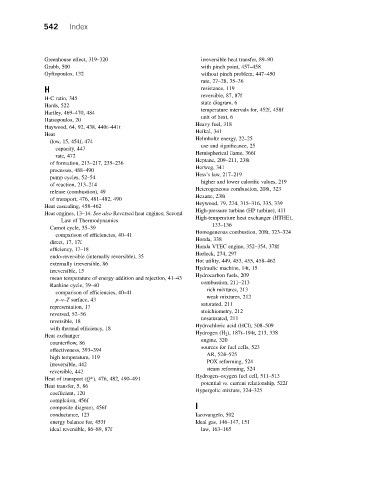Page 548 - Advanced thermodynamics for engineers
P. 548
542 Index
Greenhouse effect, 319–320 irreversible heat transfer, 89–90
Grubb, 500 with pinch point, 457–458
Gyftopoulos, 132 without pinch problem, 447–450
rate, 27–28, 35–36
H resistance, 119
reversible, 87, 87f
H-C ratio, 345
Hards, 522 state diagram, 6
Hartley, 469–470, 484 temperature intervals for, 452f, 458f
Hatsopoulos, 20 unit of heat, 6
Haywood, 64, 92, 438, 440t–441t Heavy fuel, 318
Heat Heikal, 341
flow, 15, 454f, 474 Helmholtz energy, 22–25
capacity, 447 use and significance, 25
rate, 472 Hemispherical flame, 366f
of formation, 213–217, 235–236 Heptane, 209–211, 238t
processes, 488–490 Herweg, 341
pump cycles, 52–54 Hess’s law, 217–219
of reaction, 213–214 higher and lower calorific values, 219
release (combustion), 49 Heterogeneous combustion, 208t, 323
of transport, 476, 481–482, 490 Hexane, 238t
Heat cascading, 458–462 Heywood, 79, 274, 315–316, 335, 339
Heat engines, 13–14. See also Reversed heat engines; Second High-pressure turbine (HP turbine), 411
Law of Thermodynamics High-temperature heat exchanger (HTHE),
Carnot cycle, 35–39 133–136
comparison of efficiencies, 40–41 Homogeneous combustion, 208t, 323–324
direct, 17, 17f Honda, 338
efficiency, 17–18 Honda VTEC engine, 352–354, 378f
endo-reversible (internally reversible), 35 Horlock, 274, 297
externally irreversible, 86 Hot utility, 449, 453, 455, 458–462
irreversible, 15 Hydraulic machine, 14t, 15
mean temperature of energy addition and rejection, 41–43 Hydrocarbon fuels, 209
Rankine cycle, 39–40 combustion, 211–213
comparison of efficiencies, 40–41 rich mixtures, 213
p–v–T surface, 43 weak mixtures, 212
representation, 17 saturated, 211
reversed, 52–56 stoichiometry, 212
reversible, 18 unsaturated, 211
with thermal efficiency, 18 Hydrochloric acid (HCl), 508–509
Heat exchanger Hydrogen (H 2 ), 187t–194t, 213, 338
counterflow, 86 engine, 320
effectiveness, 393–394 sources for fuel cells, 523
high temperature, 119 AR, 524–525
irreversible, 442 POX reforming, 524
reversible, 442 steam reforming, 524
Heat of transport (Q*), 476, 482, 490–491 Hydrogen–oxygen fuel cell, 511–513
Heat transfer, 5, 86 potential vs. current relationship, 522f
coefficient, 120 Hypergolic mixture, 324–325
completion, 456f
composite diagram, 456f I
conductance, 123 Iacovangelo, 502
energy balance for, 453f Ideal gas, 146–147, 151
ideal reversible, 86–89, 87f law, 163–165

